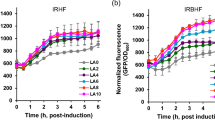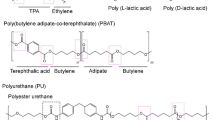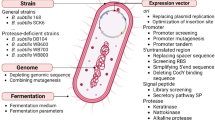Abstract
GD-95-10 and GD-95-20 lipases are modified GD-95 lipase variants, which lack 10 and 20 C-terminal amino acids, respectively. Previous analysis showed that GD-95-10 lipase has higher activity than GD-95 lipase, while GD-95-20 lipase almost completely loses its activity. Analysis in silico suggested three conservative amino acids at region between 369 and 378 amino acids which can be relevant to the activity of GD-95-10 lipase. These amino acids have direct contacts with residues involved in substrate binding, stabilization of the serine loop or form oxyanion hole. In this work, the role of Asp371, Phe375, and Tyr376 on activity, functionality, and structure of GD-95-10 lipase was analyzed by Ala scanning mutagenesis. We showed that even a single mutation can impact the main structure and activity of Geobacillus lipases. Our experiments provide new knowledge about lipases from thermophilic Geobacillus bacteria and are important for protein engineering and synthetic biology. These enzymes and their engineering can be basis for future biocatalysts applied in production of biofuel or other industrial esters.






Similar content being viewed by others
References
Sangeetha, R., Arulpandi, I., & Geetha, A. (2011). Bacterial lipases as potential industrial biocatalysts: an overview. Research Journal of Microbiology, 6(1), 1–24.
Jaeger, K. E., & Reetz, M. T. (1998). Microbial lipases form versatile tolls for biotechnology. Tibtech, 16, 396–403.
Bornscheuer, U. T. (2002). Microbial carboxyl esterases: classification, properties and applications in biocatalysis. FEMS Microbiology Reviews, 26, 73–81.
Singh, R., Gupta, N., Goswami, V. K., & Gupta, R. (2006). A simple activity staining protocol for lipases and esterases. Applied Microbiology and Biotechnology, 70, 679–682.
Hasan, F., Shah, A. A., Javed, S., & Hameed, A. (2010). Enzymes used in detergents: lipases. African Journal of Biotechnology, 9(31), 4836–4844.
Sharma, D., Sharma, B., & Shukla, A. K. (2011). Biotechnological approach of microbial lipase: a review. Biotechnology, 10(1), 23–40.
Maynard, J. A., Chen, G., Georgiou, G., & Iverson, B. L. (2002). In vitro scanning-saturation mutagenesis. Methods in Molecular Biology, 182, 149–163.
Moreira, I. S., Fernandes, P. A., & Ramos, M. J. (2007). Computational alanine scanning mutagenesis—an improved methodological approach. Journal of Computational Chemistry, 28, 644–654.
Morrison, K. L., & Weiss, G. A. (2001). Combinatorial alanine-scanning. Current Opinion in Chemical Biology, 5, 302–307.
Gibbs, C. S., & Zoller, M. J. (1991). Identification of electrostatic interaction that determine the phosphorylation site specificity of the camp-dependent protein kinase. Biochemistry, 30, 5329–5334.
Blaber, M., Baase, W. A., Gassner, N., & Matthews, B. W. (1995). Alanine scanning mutagenesis of the alpha-helix 115–123 of phage T4 lysozyme: effects on structure, stability and the binding of solvent. Journal of Molecular Biology, 246, 317–330.
Pezzullo, M., Del Vecchio, P., Mandrich, L., Nucci, R., Rossi, M., & Manco, G. (2013). Comprehensive analysis of surface charged residues involved in thermal stability in Alicyclobacillus acidocaldarius esterase 2. Protein Engineering Design and Selection, 26(1), 47–58.
Timucin, E., & Sezerman, O. U. (2013). The conserved lid tryptophan, W211, potentiates thermostability and thermoactivity in bacterial thermoalkalophilic lipases. PloS One, 8(12), 1–17.
Gudiukaitė, R., Gegeckas, A., Kazlauskas, D., & Citavicius, D. (2014). Influence of N- and/or C-terminal regions on activity, expression, characteristics and structure of lipase from Geobacillus sp. 95. Extremophiles, 18(1), 131–145.
Sambrook, J., & Rusell, D. W. (2001). Molecular cloning: a laboratory manual. New York: Cold Spring Harbor Lab Press.
Crooks, G. E., Hon, G., Chandonia, J. M., & Brenner, S. E. (2004). WebLogo: a sequence logo generator. Genome Research, 14, 1188–1190.
Wiederstein, M., & Sippl, M. J. (2007). ProSA-web:interactive web service for the recognition of errors in three-dimensional structures of protein. Nucleic Acids Research, 35, 407–410.
Olechnovič, K., Kulberkytė, E., & Venclovas, Č. (2013). CAD-score: a new contact area difference-based function for evaluation of protein structural models. Proteins, 81(1), 149–162.
Laemmly, U. K. (1970). Cleavage of structural proteins during the assembly of the head of bacteriophage T4. Nature, 227, 380–685.
Leow, T. C., Rahman, R. N. Z. R. A., Basri, M., & Salleh, A. B. (2007). A thermoalkaliphilic lipase of Geobacillus sp. T1. Extremophiles, 11, 527–535.
Jiang, Y., Zhou, X., & Chen, Z. (2010). Cloning, expression, and biochemical characterization of a thermostable lipase from Geobacillus stearothermophilus JC. World Journal of Microbiology and Biotechnology, 26, 747–751.
Chakravorty, D., Parameswaran, S., Dubey, V. K., & Patra, S. (2011). In silico characterization of thermostable lipases. Extremophiles, 15(1), 89–103.
Carrasco-Lopez, C., Godoy, C., de las Rivas, B., Fernandez-Lorente, G., Palomo, J. M., Guisan, J. M., Fernandez-Lafuente, R., Martinez-Ripoll, M., & Hermoso, J. A. (2009). Activation of bacterial thermoalkalophilic lipases is spurred by dramatic structural rearrangements. JBC, 284(7), 4365–4372.
Tyndall, J. D. A., Sinchaikul, S., Fothergill-Gilmore, L. A., Taylor, P., & Walkinshaw, M. D. (2002). Crystal structure of a thermostable lipase from Bacillus stearothermophilus P1. Journal of Molecular Biology, 323, 859–869.
Abdul Rahman, M. Z., Salleh, A. B., Abdul Rahman, R. N., Abdul Rahman, M. B., Basri, M., & Leow, T. C. (2012). Unlocking the mystery behind the activation phenomenon of T1 lipase: a molecular dynamics simulations approach. Protein Sciences, 21(8), 1210–1221.
Goodarzi, N., Karkhane, A. A., Mirlohi, A., Tabandeh, F., Torktas, I., Aminzadeh, S., Yakhchali, B., Shamsara, M., & Ghafouri, M. A. (2014). Protein engineering of Bacillus thermocatenulatus lipase via deletion of the α5 helix. Applied Biochemistry and Biotechnology, 174(1), 339–351.
Jeong, S. T., Kim, H. K., Kim, S. J., Chi, S. W., Pan, J. G., Oh, T. K., & Ryu, S. E. (2002). Novel zinc-binding center and a temperature switch in the Bacillus stearothermophilus L1 lipase. Journal of Biological Chemistry, 277(19), 17041–17047.
Acknowledgments
This work was supported by the MITA (Agency of Science, Innovation and Technology) program “Development of industrial biotechnology in Lithuania 2011-2013,” project “Innovative tools for cosmetic industry (COSMETIZYM),” Grant No. MITA 31V-18.
Author information
Authors and Affiliations
Corresponding author
Electronic supplementary material
Below is the link to the electronic supplementary material.
Table S1
The C-score of GD-95-10 lipase and its mutant 3D models in ProSA-web server (DOC 31 kb)
Table S2
Interactions changes of important amino acids in mutated lipase structures. + - contact detectable; - relationships not detectable (DOC 323 kb)
Rights and permissions
About this article
Cite this article
Gudiukaitė, R., Gegeckas, A., Sadauskas, M. et al. Detection of Asp371, Phe375, and Tyr376 Influence on GD-95-10 Lipase Using Alanine Scanning Mutagenesis. Appl Biochem Biotechnol 178, 654–669 (2016). https://doi.org/10.1007/s12010-015-1900-z
Received:
Accepted:
Published:
Issue Date:
DOI: https://doi.org/10.1007/s12010-015-1900-z




